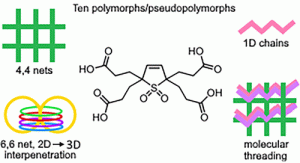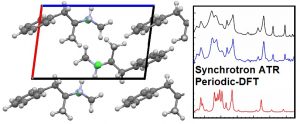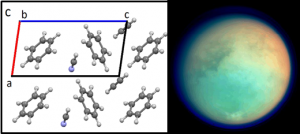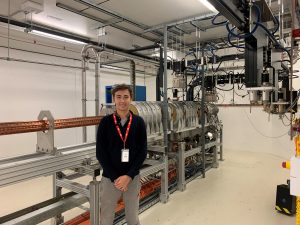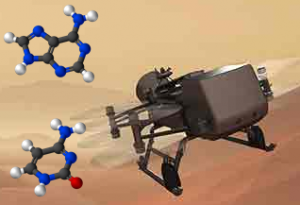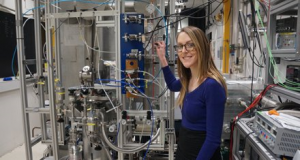Flexible Hydrogen-bonded Organic Frameworks
Just published is the Ennis workgroup’s first collaboration with the Lyall Hanton lab. This research involves Beth Lippitt’s PhD work into flexible, hydrogen-bonded organic frameworks. Our contribution includes periodic DFT calculations and vibrational mode analysis to quantify the strength of various carboxylic acid dimer bonding geometries holding these interesting structural polymorphs together.
Read more about this work here: Lippitt et al. (2020) Cryst. Growth Des.
Illicit Drug Fingerprints at the Australian Synchrotron
All welcome to read the work of Ennis group member Will Graf’s Honours (La Trobe 2018) research on the forensic detection of amphetamine class compounds using Far-Infrared wavelengths. A collaboration with the Victoria Police Forensic Services Division, Will collected spectra of a series of illicit drug samples at the Australian Synchrotron Terahertz beamline before assigning low frequency vibrational modes through periodic DFT modelling. Nice job indeed!
Link: Graf, Pearson, Appadoo, Robertson & Ennis (2020) Vibrational Spectroscopy
Ternary-phase Co-crystals on Titan
Coming out the other side of lock-down, we are happy to announce the publication of our latest DFT theory work predicting possible cyanide-bearing co-crystals in Titan’s atmosphere. This paper is our first output with new collaborators Helen Maynard-Casely at ANSTO Sydney and Morgan Cable and Robert Hodyss at NASA Jet Propulsion Laboratories. Experiments to characterise this interesting co-crystal to follow…
Link: Ennis, Cable, Hodyss, Maynard-Casely (2020) ACS Earth & Space Chemistry
Synchrotron Visit
We are excited to report that some very clean diffraction patterns were collected by Summer Scholarship holder Nick Yevstigneyev at the Australian Synchrotron Powder Diffraction beamline during the Ennis group’s latest visit. A new structure for his space ice system should be coming soon!
Here is Nick finding his way to the linear accelerator which supplies the electrons for the booster ring… during maintenance shut-down and not operation!
UORG success!
October 1, 2019
We are excited to announce that the Ennis Group has been awarded a University of Otago Research Grant (UORG) for 2020. The funding will go towards commissioning new equipment to replicate the surface chemistry of the outer Solar System and uncover new pathways for the formation of nucleobases in planetary ices. Such chemistry is a main scientific target of the recently announced Dragonfly mission to Saturn moon Titan (arriving 2034) where an autonomous drone will sample the organic-rich landscape in search of these building-blocks of life.
Congratulations to Dr Rebecca Auchettl!
March 13, 2019
Massive congratulations to Dr Rebecca Auchettl who has been awarded her PhD by La Trobe University. Her thesis entitled:
“Synchrotron Spectroscopy of Astrochemical Condensed Phase Species: Terahertz/Far-Infrared Signatures of Planetary Aerosols and Ice”
featured laboratory work to characterise cyanide aerosols within Titan’s atmosphere; condensed icy materials that could harbour important biological precursors formed by radiation chemistry. These studies were carried out at the Far Infrared beamline at the Australian Synchrotron using spectroscopic equipment custom built to replicate the intriguing environment of this moon of Saturn. Well done Bec!!
The secrets of Titan: Cassini searched for the building blocks of life on Saturn’s largest moon
September 13, 2017
Check out my article in The Conversation talking about the presence of organic materials on Titan, published to coincide with the end of Cassini’s mission to the Saturnian system.
The Secrets of Titan: Recreating a Cyanide Sky
February 8, 2018
The Royal Society of Victoria Public Lecture – February, 2018
You can watch a recording of this presentation here: https://www.youtube.com/watch?v=41ml9gl53nk
The Cassini (NASA) mission to Saturn recently came to a spectacular end with the spacecraft burning up in the gas giant’s atmosphere after 13 years of close examination of Saturn’s icy moons and rings. The research of Dr Courtney Ennis and his colleagues concerns Saturn’s largest moon Titan, a world thought chemically reminiscent of an early-Earth, complete with extended atmosphere and weather driven by small hydrocarbons.
Here in the Titan sky, we have detected quantities of cyanide family compounds seasonally generated by sunlight. Although deadly to much life on Earth, these cyanide species could act as a source of life initiating molecules – such as amino acids and DNA bases – when exposed to Titan conditions. Join astrochemist Dr Courtney Ennis, who will discuss the implications of cyanides to the origins-of-life and present current work underway at the Australian Synchrotron, where a specialised experiment to mimic the Titan atmosphere has been used to recreate its cyanide rain.

